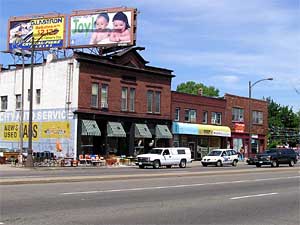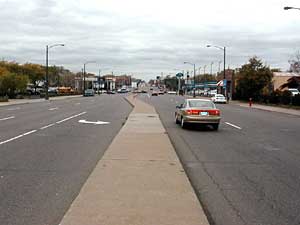Nimbyism, fear of improvement, fear of change
 Endangered(?) by light rail. Long stretches of University Ave. in St. Paul include family-owned and operated storefront businesses. Some of those business owners are concerned about the impact a light rail line might have on their success. (MPR Photo/Dan Olson)
Endangered(?) by light rail. Long stretches of University Ave. in St. Paul include family-owned and operated storefront businesses. Some of those business owners are concerned about the impact a light rail line might have on their success. (MPR Photo/Dan Olson)Steve from Arkansas (he and his wife are moving to DC) sent me an email link to the project planning for expanding light rail in the Minneapolis area, to St. Paul. The Hiawatha Line in Minneapolis is pretty popular, as was discussed in this blog entry a few months ago (Development along light-rail transit line exceeds early projections). It's discussed in this Minnesota Public Radio piece, "Light rail gets the green light for central corridor."
So I looked into this a bit deeper, and to a previous article, "What will light-rail do to St. Paul?" (real transit wonks will also want to read "Bus, rail or what between St. Paul and Minneapolis?").
Interestingly enough, one of the people quoted, an African-American woman, avers that the light rail system will have the same kind of neighborhood-destroying impact of the Interstate highway system, mentioning a particular neighborhood in St. Paul, Rondo. From the article:
But about a quarter of the people giving testimony questioned the benefits of light rail for those already living in the area. They referred to the proposal as "corporate welfare," charging that the light-rail plan would hurt, not help, the communities the train would travel through. Ora Lee Patterson was the first of several speakers to invoke St. Paul's past as a warning of what could be in store for her community.
"I have seen the tearing up of Rondo, the business community, for the sake of a freeway. And there are still some of us that are around that experienced that and we're still going through that pain, and now we're suffering the pain of a central corridor coming down the middle of the street on University Avenue and we're wondering about the ramifications of all of that," Patterson said. Patterson's glance back at Rondo sums up the fears of many low-income and minority residents living on or near University Avenue.
 The Hiawatha light-rail train passes near the Reflections Condominiums, under construction in Bloomington. Photo from the Metropolitan Council.
The Hiawatha light-rail train passes near the Reflections Condominiums, under construction in Bloomington. Photo from the Metropolitan Council.St. Paul's Rondo neighborhood was a thriving African-American business and residential district that was destroyed in the 1950s and '60s to make way for Interstate 94. St. Paul NAACP President Nathanial Khaliq says many residents are worried they'll be moved again, that they'll lose everything in the name of "progress." "We would want you to take into consideration what kind of compensation are we going to get when land values increase and many of us are going to be taxed out of the neighborhood?" he asked.
Although they are being equated, there are two very different points being made here. One is that the neighborhood will be wrecked and this will destroy personal and community networks (the kinds of arguments made in discussion about "the use value of place" by Logan and Molotch in Urban Fortunes as well as in the book Root Shock by Fullilove). Also see "Dividing Lines: The Ethnic Implications of Interstates," which discusses how "in many cases, highway builders used interstate construction to demolish low-income, especially African-American, neighborhoods."
The other is that the neighborhoods will become popular through better transit and connectedness, and that people will lose out due to increases in housing values and eventually taxes. Interestingly enough, Steve Belmont's book Cities in Full starts out explaining the decline of Minneapolis in comparison to New York City. He puts the blame on lack of density, something that transit can help to reverse.
The point made by Mr. Khaliqu jibes with something one of my H Street now nemeses said in 2001. Her argument is that many African-Americans prefer crappy neighborhoods because while it might not be that great, they don't have to worry about displacement through increased demand. Improvement is a double-edged sword.
I wonder if this is relevant to figuring out the opposition of some community members to bringing streetcars to Anacostia, which I wrote about last year in Whither Light rail in Anacostia? as well as When seeing isn't believing, how do you correct for vision impairment?. A couple weeks ago, I wrote something similar,about Seattle, "Better transit as a "gentrifying" force."
On the other hand, it speaks to something else that bugs me, and that's people's inability to make nuanced judgements. I've argued with people who equate historic preservation to urban renewal, and for the life of me I don't see the similarity. How is having all your houses being torn down and your being forced to move and live somewhere else any way comparable to saving neighborhoods, which is what adding quality transit can do? Unless people are thinking about the improvement that might come and the kinds of long term implications indicated by Mr. Khaliqu. I say might, because the kind of neighborhood improvements experienced in Washington (in part due to access to public transportation assets) are not happening in the same way in places like Milwaukee or Detroit or Pittsburgh or Cleveland, etc.
However, I have argued again and again that we need to deal with this real issue of the financial costs that come from neighborhood investment. Somehow, the way the property tax system works (being based as it is on current value, which is disconnected from the income and ability of the property owner to pay) needs to be reformed. I have never been able to figure out the land value tax system of Henry George, but I guess that might be the way to go.
Today's Wall Street Journal column on the front page of the Marketplace section is about opposition to the American Revolution and it starts with this:
In June 1776, just a month before the Declaration of Independence was ratified, the white men of Barnstable, Massachusetts, voted on whether America should break its bonds with Great Britain. The tally: 30 for independence, 35 against, and 65 abstentions.
It appears as if advocating change in America has been contentious from the very beginning.
 The Central Corridor linking St. Paul and Minneapolis, a potential light rail transit corridor. Minnesota Public Radio Photo.
The Central Corridor linking St. Paul and Minneapolis, a potential light rail transit corridor. Minnesota Public Radio Photo.Index Keywords: contested-spaces; transit; urban-revitalization



0 Comments:
Post a Comment
<< Home